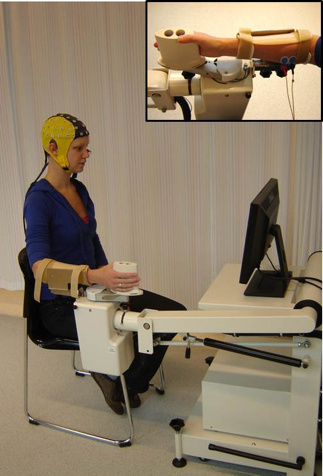People
- S.F. Campfens, MSc (PhD student)
- Dr. ir. A.C. Schouten
- Prof. dr. ir. H. van der Kooij
- Prof. dr. ir. M.J.A.M. van Putten
Goal
The goal of this project is to develop and test system identification techniques for the identification of the corticospinal circuits.
Background
In controlling movements humans use different levels of the central nervous system: the spinal cord, the brainstem and multiple areas of the cortex. Motor commands are generated by the primary motor cortex and are sent towards the muscles. Sensory feedback takes the reverse pathway and travels from the muscles towards the cortex where it is processed and new motor commands are generated based on the sensory feedback.
Currently, corticomuscular coherence is used to quantify the functional coupling between cortex and muscles in motor control. Coherence does not provide functional or dynamical information about the underlying system. Within this project we will apply system identification to characterize the dynamical properties of the corticospinal and corticomuscular circuits involved in motor control.
Techniques
System identification of closed-loop systems, such as the motor control system, uses external perturbations in order to ‘open’ the system. We will use mechanical perturbations of the wrist as a perturbation during a force task. The EMG and EEG signals will be measured in order to measure the response of the system.
Different types of perturbations are used in combination with different coupling measures, such as corticomuscular coherence and stretch evoked potentials, to quantify corticomuscular coupling.

History and Milestones
07-2009 | Start Project |
01-2010 | First experiments on CMC using the Wristalyzer |
03-2010 | Bachelor assignment “CMC in force and position tasks” by Irene Staal |
04-2011 | Start of METC approved study: corticomuscular coupling in response to mechanical perturbations. |
01-2012 | Collaboration with dr. Carel Meskers (Leiden University Medical Centre) on the EXPLORE-stroke project: Corticomuscular coupling after stroke. |
09-2012 | Master assignment “Assessing afferent pathways to improve predictions of motor recovery after stroke” by Sarah Zandvliet (Faculty of human movement sciences, VU, Amsterdam, the Netherlands) |
10-2012 | Master assignment “The afferent contribution to corticomuscular coherence using a neuronal model of the spinal cord” by Clément Rohner (EPFL, Lausanne, Switzerland) |
04-2013 | Full paper accepted for publication: Campfens et al. 2013 Exp Brain Res |
Publications
- A.C. Schouten & S.F. Campfens, 2012, Directional coherence disentangles causality within the sensorimotor loop, but cannot open the loop. Journal of Physiology 590 (Pt 10) – Comment on C.L. Witham et al., 2011, Contributions of descending and ascending pathways to corticomuscular coherence in humans. Journal of Physiology 589 (Pt 15)
- S.F. Campfens, A.C. Schouten, M.J.A.M. van Putten & H. van der Kooij, 2013, Quantifying connectivity via efferent and afferent pathways in motor control using coherence measures and joint position perturbations. Experimental Brain Research 228(2)
Conference contributions
- 01-2011: Corticomuscular coupling: different coupling measures and system identification. S.F. Campfens, M.J.A.M. van Putten, A.C. Schouten, H. van der Kooij. 3rd Dutch Biomedical Engineering Conference 2011, Egmond aan Zee, the Netherlands
- 06-2011: Corticomuscular system tunes to external perturbation during a motor task as revealed by corticomuscular coherence. S.F. Campfens, A.C. Schouten, H. van der Kooij, M.J.A.M. van Putten. 14th European Congress on Clinical Neurophysiology, Rome, Italy
- 10-2012: Reproducability of corticomuscular coherence: a comparison between static and perturbed tasks. S.F. Campfens, A.C. Schouten, M.J.A.M. van Putten, H. van der Kooij. Annual meeting of the Society for Neuroscience 2012, New Orleans, USA
- 10-2012 Disentangling causality of corticomuscular coherence within the sensorimotor loop. A.C. Schouten & S.F. Campfens. Annual meeting of the Society for Neuroscience 2012, New Orleans, USA
- 09-2013 Time delays cannot be estimated from the phase-frequency relationship of coherence. A.C. Schouten, S.F. Campfens, H. van der Kooij. International Conference on Basic and Clinical Multimodal Imaging, Geneva, Switzerland
